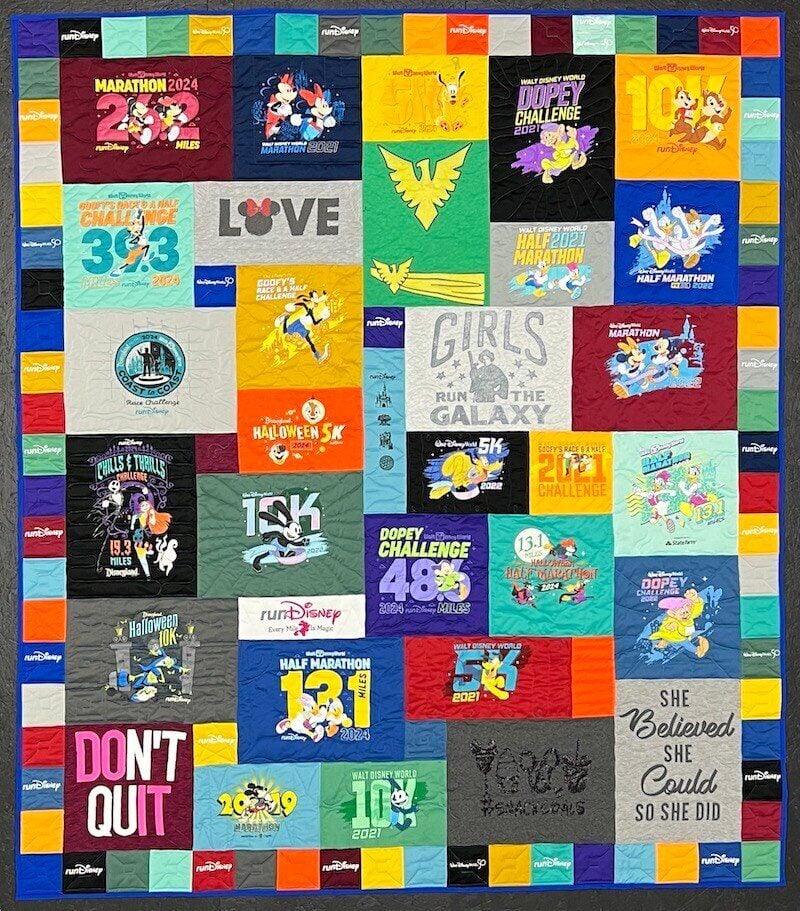
6 Things to Look for in Photographs of T-shirt Quilts.
- Blocks with images cropped off.
- Graphics with too much blank space around them.
- Look for Quilting.
- The spacing of the quilting.
- The quilting pattern.
- The quilt's binding.
Are you looking at photos of T-shirt quilts on the Internet trying to figure out which company to send your T-shirts to? How can you tell from a photograph which T-shirt quilts are awesome? How can you tell which ones to stay away from?
Here are 6 things you can look for in a photograph of a T-shirt quilt that will help you judge the quality of the quilt.
1. Look for Blocks With Images Cropped Off
Look for graphics that have not been used in full. In other words, part of the design has been cropped or cut off.
You will see this primarily in T-shirt quilts that use one size block. This is called a traditional style T-shirt quilt. The one-size-fits-all method of making T-shirt quilts uses just one size block. Typically, a 12” or 14” square is used.


In the examples here, the photos are of a quilt and a blanket with the same T-shirt. In the first photograph, the image is used in its entirety. This is because the block was cut large enough to capture the entire graphic. The second photograph shows the same graphic cropped off. This was used in a traditional style blanket. You totally miss the word Motorcycle in the second example!
The traditional method of making T-shirt Quilts does not take into account that designs and images on T-shirts come in all different sizes. If an image is larger than the block size, it’s cut off.
For example, a company like Project Repat, uses a 12” block. If you choose them make a T-shirt blanket, then any graphic that is larger than 12” wide or tall, will be cropped off. Look at your T-shirts. Measure the graphics on your T-shirts. Can you live with part of the image cut off?
Don’t want your graphics cropped off? You will need to choose a puzzle style of T-shirt quilt. Read more about the 6 styles of T-shirt quilts here.
FYI - A quality quilt does not have images that are chopped off.
2. Look for Graphics With Too Much Blank Space Around Them
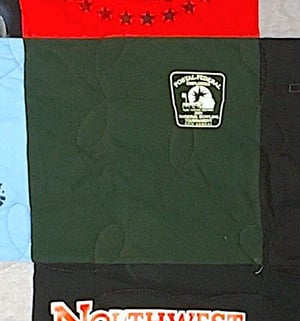 When you are studying quilt photos, look for blocks with a lot of blank area. This happens when a very small chest logo gets cut with a large size block.
When you are studying quilt photos, look for blocks with a lot of blank area. This happens when a very small chest logo gets cut with a large size block.
This is another result of the one-size-fits-all block design. As a T-shirt’s image that is too large gets cropped off, an image that is much smaller than the block is left with too much “white space.”
This is very noticeable in a breast logo. First, there is too much blank space around the design. And worse, you will see that the image is stuck in the upper right hand corner of the block. This is because there is not enough fabric around the top and right side of a small design to center the design. To have enough fabric to fill up the block, the graphic is placed off center.
This looks wrong. And it’s a waste of space.
Planning a T-shirt quilt?
Here are step-by-step directions for ordering your Too Cool T-shirt quilt.
3. Look for Quilting
Quilting of Each Individual Block versus Overall Quilting.Quilting of Each Individual Block versus Overall Quilting.
When you are looking at a photo, if a block looks smooth and flat, it has not been quilted. This also means that the quilt you are looking at is probably a blanket. Read more about the difference between a blanket and a quilt here.
Right away this is a sign of a low-quality T-shirt blanket. Without quilting, nothing holds the front to the back. The result is that the T-shirt side will sag and stretch out over time. This will decrease the life of the blanket.
 There is a big difference between a quilt and a blanket. A blanket is on the low end of the scale and a quilt towards the other end.
There is a big difference between a quilt and a blanket. A blanket is on the low end of the scale and a quilt towards the other end.
This is very important to understand because you might think you are getting a quilt. But you may end up with a blanket. And that could break your heart.
The quilt in the first photo here is a quilt and you can see the quilting. In the second photo, you can't see any quilting. Thus it is a blanket.


If you are unsure if you are looking at a quilt or a blanket, ask. Don’t assume that a company is making a quilt just because they call it a quilt on their website. Some companies call their blankets a quilt because it’s what people are looking for. Other makers just don’t know the difference. You need to know the difference.
Ask about the quilting done on the quilt. If you are unable to pick up on this in a photograph, asking might be the only way you know for sure.
You can definitely see the lack of quilting from the back of these two examples. They are the same quilts/blanket from the previous photos.

4. Look at the Spacing of the Quilting.
When you look at photographs, try to zoom and or look for close up photos. Look for the density of the quilting on the quilt. You want to see a lot of quilting. This is a sign of a great quilt. If the quilting is spread out and sparse, continue your search. The less quilting you see, the lower the quality quilt.
Look at the photos below. This first photo shows the back of a Campus Quilt on the left and a Too Cool T-shirt Quilt on the right. There is more quilting in one block of the Too Cool quilt than there is in the entire Campus quilt. By comparing photographs of the backs of quilts, you should be able to see the difference in density of the quilting.
Again, the more quilting, the longer life the quilt will have.
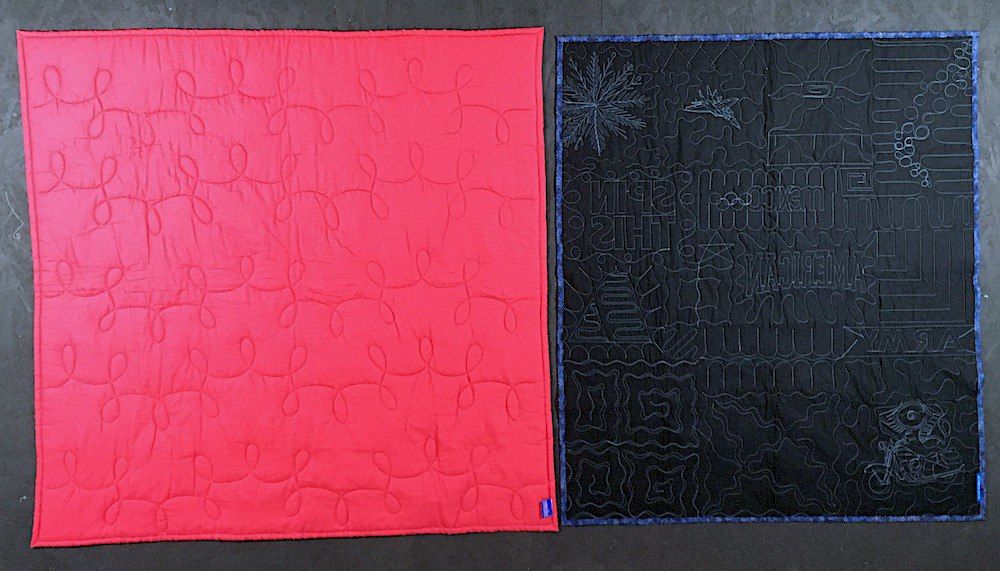
5. Look for the quilting pattern.
When you look at a photo, look beyond the T-shirts to the quilt as a whole. Try to see the quilting pattern.
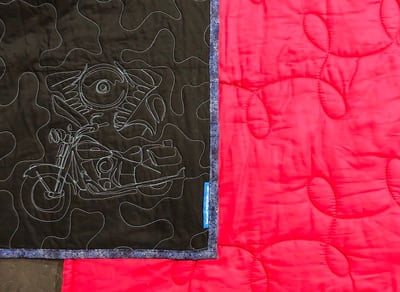 Is the quilting an all-over pattern like the quilt on the left above? Or is each block uniquely quilted like the left-hand quilt?
Is the quilting an all-over pattern like the quilt on the left above? Or is each block uniquely quilted like the left-hand quilt?
More intricate the quilting increases the quality of the quilt. All-over patterns are very easy to do and don’t require a talented artist. The quilting you see above on the left is quilted in an overall pattern.
Read more about the quilting here.
6. Look to See How the Quilt Is Bound
A binding is the fabric that runs around the entire edge of the quilt finishing the raw edges. There are three methods of finishing a quilt – read more about bindings here.
When you are looking at photos, focus on the edge of the quilt. You probably will see 1 of the 3 methods of binding a quilt.
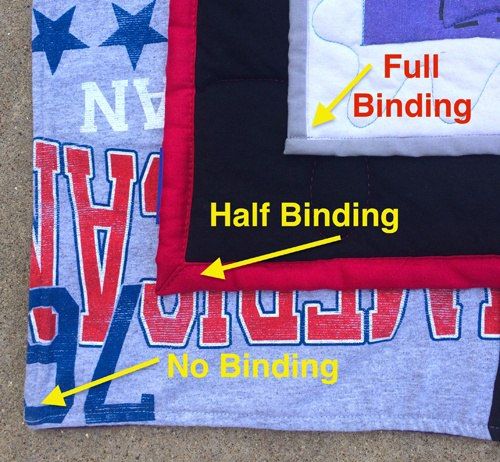 No Binding
No Binding
One the front, if you see the T-shirts just end, there is no binding. On the back this will look like the material just stops. This means that what you are looking at is a blanket and not a quilt.- Half Binding
On the front of a quilt with a half binding, you will see a small color strip along the edge. On the back, you will only see the fabric end.
A half binding pulls the fabric from the back around to the front of the quilt. A half binding is easy and doesn’t require any additional fabric. It also means that you can’t have a different color binding and backing. - Full Binding
This is what you want to look for! On both the front and the back of the quilt you will see a thin strip of material along the edge of the quilt. This is the more sophisticated style of binding. With a full binding, you can choose to use the same color you use on the back of your quilt for the binding. Or you can choose to use a contrasting color.
With a full binding, you can choose to use the same color you use on the back of your quilt for the binding. Or you can choose to use a contrasting color.
Either way, the binding is made with a separate piece of material.
Look photographs of the fronts and backs of quilts. You may need to look at a few different quilts to find one with a binding color that contrast from the backing color. If you don’t find an example like this, you might be looking at a company that uses a half binding method.
If you can’t tell from the photo, you can ask the quilter how the quilt is bound.
Material Quality – It Can Be Difficult to See
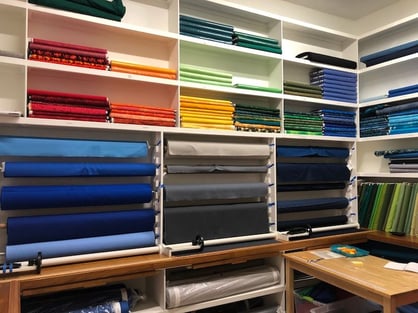 It can be difficult to tell the difference between a quilt made high quality materials and one made with low quality materials. Sometimes you just can’t tell this from a photograph. This is a time to ask!
It can be difficult to tell the difference between a quilt made high quality materials and one made with low quality materials. Sometimes you just can’t tell this from a photograph. This is a time to ask!
Here are things that you will need to ask about to know a quilt’s quality:
- What type of backing material is used?
This should be 100% cotton. Not a bed sheet and not a poly-cotton blend. Read more about backing materials here.
- What type of batting is used?
This should be 100% cotton or an 80% cotton/20% polyester blend. Not 100% polyester. If they are not using batting it means they are making blankets. Read more about batting here.
- Is iron-on interfacing used on the back of the T-shirts?
This should be no. Iron on interfacing or stabilizer will make it easier for a quilter to sew the quilt, but it’s not good for you – it will leave your quilt stiff! Read more about iron-on backing (aka interfacing) here.
There is a lot to know about having a quilt made from your T-shirts. We hope that we have helped you figure out how to look at in a photograph so you have a good starting place.
Want to learn more about T-shirt quilts? Visit our Learning Center.
We have over 200 articles about all aspects of T-shirt quilts.

Andrea Funk is the inventor of T-shirt quilts made with multiple blocks sizes. The modern method of making T-shirt quilts. In 1992 she founded Too Cool T-shirt Quilts. Her life has been immersed in T-shirt quilts ever since.


